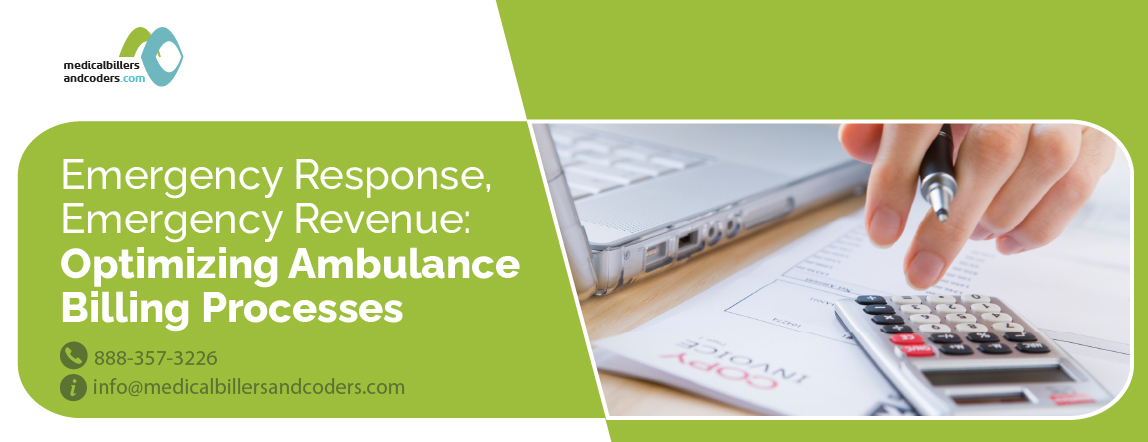
Can Optimizing Ambulance Billing Unlock Your Revenue Potential? Let’s Find Out!
In the world of emergency medical services, every second counts; but what about the revenue generated from those crucial responses? Are your ambulance billing processes streamlined to ensure maximum revenue collection? Optimizing ambulance billing is essential for improving cash flow as well as sustaining high-quality patient care.
Ambulance services face unique challenges, including complex billing codes, insurance regulations, and changing reimbursement models. A study from the American Ambulance Association revealed that improper billing could cost EMS agencies millions annually. Thus, understanding the intricacies of ambulance billing services is crucial for financial health and sustainability.
Understanding Revenue Cycle Management (RCM) in Ambulance Billing:
Revenue cycle management (RCM) plays a pivotal role in optimizing ambulance billing. RCM encompasses the entire billing process, from patient registration to final payment. This process includes several key performance indicators (KPIs) that are essential to monitor:
1. Days in Accounts Receivable (AR): Measures the average time taken to collect payment.
Formula: Total Accounts Receivable / Average Daily Charges.
2. Clean Claim Rate: The percentage of claims accepted without any errors on the first submission.
Formula: Clean Claims / Total Claims Submitted.
3. Denial Rate: The percentage of claims denied by payers.
Formula: Denied Claims / Total Claims Submitted.
Tracking these KPIs enables ambulance services to identify areas of improvement––thereby optimizing their billing processes. By understanding where inefficiencies lie, providers can implement targeted strategies to enhance their revenue cycle, reduce claim denials, and improve cash flow.
5 Proven Strategies for Optimizing Ambulance Billing:
1. Leverage Technology:
Utilize billing software that integrates directly with electronic health records (EHR) systems. This facilities seamless data transfer and reduces manual entry errors. Set up automated alerts within the software to flag potential coding issues or missing documentation before claims are submitted––minimizing the risk of denials.
2. Training and Education:
Create a structured, ongoing training program that includes monthly updates on new regulations or payer policies, ensuring staff are always compliant with the latest standards. Implement competency tests after training sessions to verify staff understanding and immediately address any gaps in knowledge.
3. Focus on Documentation:
Establish standardized templates for ambulance reports that prompt field personnel to capture all necessary details, such as medical necessity and mileage, which are critical for clean claims. Implement regular audits of documentation to identify recurring issues and provide corrective feedback to staff in real time.
4. Streamline Claim Submissions:
Implement a batching process for claims submissions, ensuring that claims are grouped and sent at optimal times for faster processing. Utilize clearinghouses to pre-scrub claims for common errors, reducing the chance of denials and speeding up the reimbursement cycle.
5. Engage with Payers:
Schedule quarterly meetings with major insurance payers to discuss common reasons for denials and explore ways to streamline claims processing. Build a dedicated liaison team within your organization to manage payer relationships, ensuring timely resolution of claims disputes and better overall communication.
Outsourcing to Experts: A Smart Solution for Optimizing Ambulance Billing
Partnering with a reputable billing service like Medical Billers and Coders (MBC) can be a game-changer. MBC specializes in optimizing revenue cycle management for ambulance services.
Benefits of outsourcing ambulance billing services include:
- Save Time and Reduce Stress: Focus on providing quality care while MBC handles complex billing tasks.
- Maximize Accuracy and Collections: Ensure accurate billing, which translates to higher collections.
- Data-Driven Insights: Leverage data analysis to benchmark performance and identify areas for growth.
- Standardized Processes: Benefit from streamlined documentation and billing procedures.
- Dedicated Support: Get personalized service with a dedicated account manager offering regular updates.
- Technology Integration: MBC is system-agnostic and works seamlessly with your existing software.
Optimize Your Ambulance Billing Efficiency Before It's Too Late!
Don’t let inefficient billing drain your revenue—reach out to MBC today and secure your financial future.
FAQs
Q: What are the most common challenges in ambulance billing?
A: Common challenges include complex coding, high denial rates, and inefficient claim processing, which can hinder revenue collection.
Q: What is the code for ambulance billing?
A: Ambulance billing typically uses the HCPCS codes, starting with "A" for ambulance services, such as A0428 for basic life support transport.
Q: What is the CPT code for ambulance mileage?
A: The CPT code for ambulance mileage is A0425, which accounts for mileage per mile for ambulance transportation.
Q: What are the compliance regulations for ambulance billing?
A: Ambulance billing must comply with Medicare, Medicaid, and private payer guidelines, including correct coding and documentation to avoid penalties and denials.
Q: Where can you get detailed and accurate information related to ambulance billing?
A: You can find detailed and accurate information on ambulance billing through the Centers for Medicare and Medicaid Services (CMS) guidelines or reputable billing resources like the American Medical Association (AMA).


